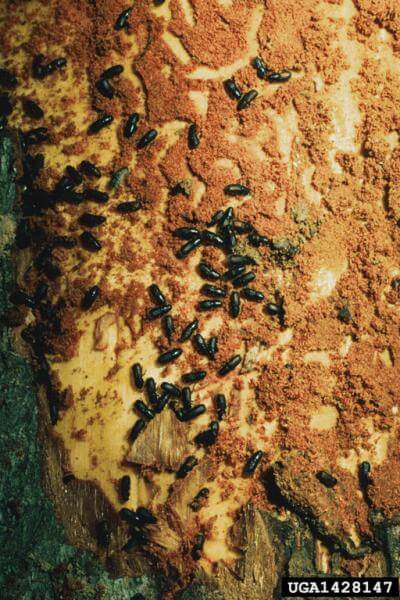
The red-haired pine bark beetle is native to Mediterranean areas and Africa but has been introduced to South America, Japan, Sri Lanka, Australia, and New Zealand (Ciesla, 1993). The species can be imported on solid wood packing material made of pine, for example, cargo crates (Ciesla, 1993), and infested logs (Sato, 1975) and is occasionally intercepted by APHIS at United States ports. An infestation of the species was discovered in November 2000 at a Christmas tree plantation in Rochester, New York (T. Hofaker, pers. comm., 2001). Subsequent surveys in 2001 detected two additional infestations in the same county, as well as small infestations in two adjacent counties.In July 2003, the red-haired pine bark beetle was detected in two locations in Los Angeles County. By early 2007, it is known to be established in six counties in southern California–Los Angeles, Orange, Riverside, San Bernardino, San Diego, and Ventura (Statewide Integrated Pest Management Program, University of California, Davis. Press release March 19, 2007).
The red-haired pine bark beetle can vector pathogenic fungi (Ciesla, 1988; Zhou et al., 2001). Silvicultural controls include removal of tree stumps and slash to limit breeding habitat and a delay in planting of seedlings for six to nine months after harvest.
USFS scientists and managers developed a conservation priority-setting framework for forest tree species at risk from pest & pathogens and other threats. The Project CAPTURE (Conservation Assessment and Prioritization of Forest Trees Under Risk of Extirpation) uses FIA data and expert opinion to group tree species under threat by non-native pests into vulnerability classes and specify appropriate management and conservation strategies. The scientists prioritized 419 tree species native to the North American continent. The analysis identified 15 taxonomic groups requiring the most immediate conservation intervention because of the tree species’ exposure to an extrinsic threat, their sensitivity to the threat, and their ability to adapt to it. Each of these 15 most vulnerable species, and several additional species, should be the focus of both a comprehensive gene conservation program and a genetic resistance screening and development effort. Golden haired pine bark beetle is not known to be a threat to any of these 15 most vulnerable species.
Sources
Ciesla, W. 1993. Recent introductions of forest insects and their effects: a global overview. FAO Plant Prot. Bull. 41: 3-13.
Ciesla, W. 1988. Pine bark beetles: a new pest management challenge for Chilean foresters. J. For. 86: 27-31.
Hofaker, Tom. March 2001. USDA Forest Service, 1601 North Kent Street, Arlington, Virginia 22209, personal communication.
Potter, K.M., Escanferla, M.E., Jetton, R.M., Man, G., Crane, B.S., Prioritizing the conservation needs of US tree spp: Evaluating vulnerability to forest insect and disease threats, Global Ecology and Conservation (2019), doi: https://doi.org/10.1016/
Sato, K. 1975. A list of bark beetles and pin-hole borers imported into Japan with timbers from abroad. Res. Bull. Plnat Prot. Ser. Japan 12: 2-67.
Zhou, X. D., Z. W. de Beer, B. D. Wingfield, and M. J. Wingfield. 2001. Ophiostomatoid fungi associated with three pine-infesting bark beetles in South Africa. Sydowia 53: 290-300.



